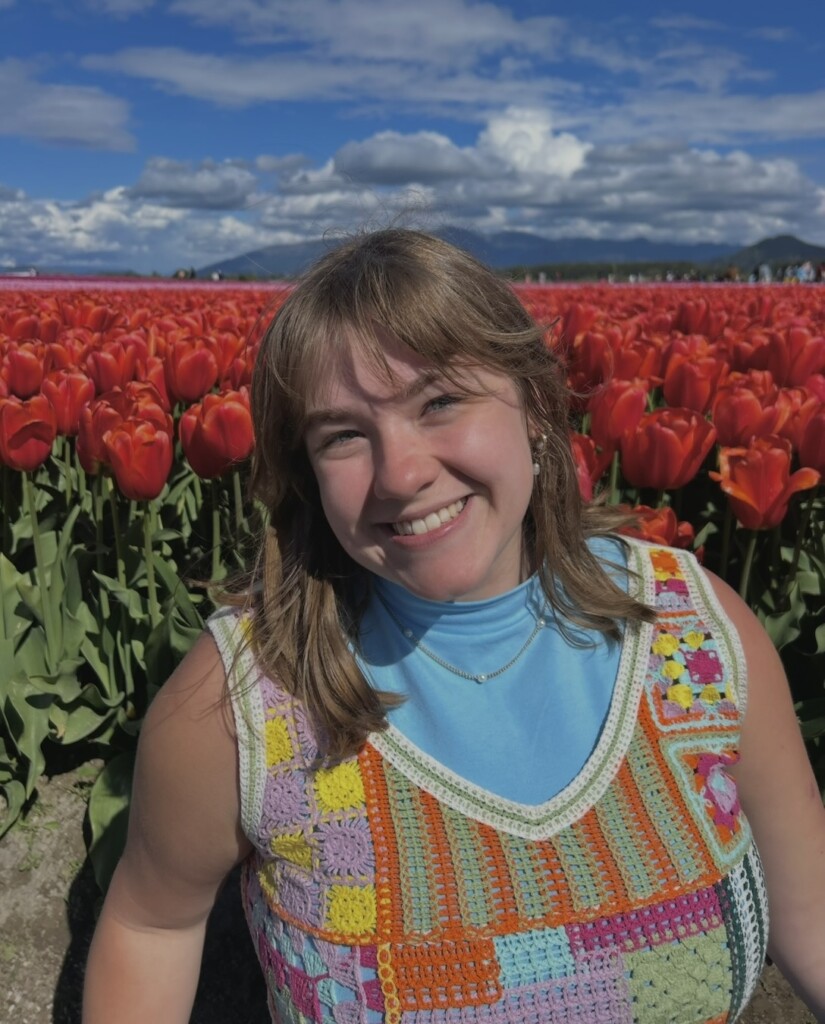2025 Environmental Studies Capstone Presentations
Monday May 19, 2025
2:00-5:00pm in Rieke 103B
2:10-2:30pm, Fires Still Burning : Indigenous Displacement and the Circular Forces of Erasure in Yellowstone
Alina Boorse
This paper exposes how the establishment of Yellowstone National Park in 1872 was fundamentally intertwined with the systematic displacement of Indigenous peoples who had inhabited and stewarded these lands for millennia. I challenge the romanticized “campfire myth” of Yellowstone’s creation by analyzing the circular, self-reinforcing relationship between three interconnected forces of erasure: conflicting conceptions of land ownership, American wilderness philosophies that imagined “pristine” landscapes devoid of human influence, and systematic U.S. displacement policies. Drawing from history, political philosophy, and Indigenous studies, the analysis reveals how Lockean property concepts privileged European-style agriculture while rendering Indigenous stewardship invisible, how the myth of pristine wilderness erased over 11,000 years of continuous Indigenous presence, and how treaties and federal policies operationalized these ideologies through concrete mechanisms of dispossession. The paper concludes by examining contemporary efforts to acknowledge Indigenous connections to Yellowstone, arguing that while progress has been made, true reconciliation requires a fundamental reimagining of conservation frameworks to center Indigenous rights, knowledge systems, and continuous relationships with ancestral lands.
Thank you to Dr. Naasz for your guidance throughout this capstone project. To my mentors, Dr. Crawford O’Brien and Dr. Artime, your wisdom has been invaluable. To Aaron, your support kept me grounded through the late nights and moments of doubt. And to my frisbee friends, thank you for always checking in and providing necessary breaks from the academic grind. This work wouldn’t have been possible without all of you.

2:30-2:50pm, The Electric Future: Assessing Advanced Clean Car’s Environmental Policy in Washington State
Avery McGinnis
This research analyzes the current state of electric vehicle implementation in Washington state specifically looking at the Advanced Clean Cars II rule policy, and the goals it has set for EV sales. Though electric vehicles may be the future of transportation, policies like Advanced Clean Cars II are setting high goals for EV implementation and must be effective in considering all economic and environmental outcomes while keeping the end goal of increased sustainability from transportation in sight. This research is meant to assess the positive and negative outcomes of the implemented policy, using evaluation frameworks that show the barriers this policy has environmentally and economically that may hinder its ability to reach its goals. Research will also estimate the environmental and economic outlook of electric vehicle implementation, especially looking at the goal of emissions reductions resulting from increased EV’s. While this research does attempt to find gaps in the current policies effectiveness it should be used as both insight for policymakers to guide changes towards Advanced Clean Cars II and also serve as an informative piece to Washington state residents on what changes to expect from vehicles and transportation in the state.
I’d like to thank Dr. Naasz for serving as both my professor for this course and mentor for this project, especially for keeping me on the right track to finish. I’d like to thank Dr. Ryan Swartzentruber for mentoring and guiding this research as well. I’d like to thank the Environmental Studies department and all of my peers for providing insight and comments on this work. Finally I’d like to thank the PLU baseball program, and my family back home for their continued support of me and my academics.

2:50-3:10pm, Buddhist Perspectives, Conservation Biology, and Invasive Aquatic Species
Dylan Keegstra
American bullfrogs are a harmful aquatic invasive species that thrive in a variety of freshwater aquatic ecosystems they are introduced to, threatening native amphibians. The Buddhist religious practice of prayer release involves releasing captive animals into ecosystems, intended to spiritually benefit the practitioners and the animals they release. In Southwestern China, various Buddhist temples release American bullfrogs as part of prayer release ceremonies, which makes these ceremonies are a harmful release vector for the invasive species. My project evaluates the harmful impact invasive American bullfrogs have on aquatic ecosystems in Southwestern China and how prayer release has contributed to the spread of American bullfrogs. I analyze the issue with a Zen Buddhist lens, using the book Mindfully Green: A Personal and Spiritual Guide to Whole Earth Thinking, written by Buddhist thinker Stephanie Kaza, to establish an argument for why the Buddhists performing the ritual should adjust their behavior to reduce environmental harm. I argue for the merits of religious people and scientists sharing ideas and perspectives instead of working against each other.
Thank you Dr. Brian Naasz, Dr. Michael Behrens, and Dr. Kevin O’Brien for all your help, guidance, and feedback for this project.

3:10-3:20pm, Break
3:20-3:40pm, Fashioning a Future: Sustainable Supply Chain Management as a Pathway to Biodiversity Conservation
Sydney Aoki
Fast fashion has become a rapidly expanding industry, offering cheap, trendy clothes at an extremely fast pace but at a significant cost to the planet. While consumers often focus on price and style, many are unaware of the environmental toll behind the production process. Fast fashion companies rely on excessive water usage and release large quantities of untreated toxic dyes into waterways, severely harming aquatic ecosystems and nearby communities. This paper focuses specifically on the water pollution caused by textile dyeing and the devastating effects it has on both environmental and human health. The issue is often overlooked, particularly in wealthier countries, because the damage occurs far from view in developing regions with weaker environmental regulations and oversight. To address these problems, I propose a water-centered Sustainable Supply Chain Management (SSCM) model. This model combines key aspects of Oeko-Tex and GOTS certifications, encourages the adoption of solution dyeing, and mandates full supply chain transparency. Although there are currently no unified standards for SSCM in the fashion industry, several environmentally conscious brands are already implementing aspects of it, proving that change is both possible and practical. However, for meaningful impact, the responsibility cannot rest on a few companies alone. It requires government regulation, corporate accountability, and more informed consumer choices. This paper advocates for both systemic reform and individual action. By understanding the hidden impacts of our clothing and supporting sustainable alternatives, consumers can help push the fashion industry toward a more ethical and environmentally responsible future.
Thank you to Dr. Naasz, Dr. Behrens, and Dr. Fawcett for all of your guidance and support throughout my capstone journey. Additionally, I would like to thank my family and friends for all the love and support you have given me. And to Mack, your unwavering support pushed me to work through all the very late nights.

3:40-4:00pm, From Vibrant Reefs to Fading Shores: The Economic Intersection of Coral Bleaching and Coastal Tourism
Lorianne Price
Coral bleaching is a growing environmental problem driven by rising ocean temperatures, change of ocean pH, and climate change. As coral reefs lose their vibrant colors and health declines, the consequences of coral bleaching has become more than losing coral itself. Coral reefs support a large range of marine life. When bleaching occurs, the biodiversity decreases which threatens the survival of thousands of species that rely directly or indirectly on coral. Not only does coral bleaching cause ecological loss, it also disrupts the stability of marine ecosystems. It disrupts the food chains and natural balances in the ecosystem. Loss of healthy corals directly impacts coastal communities as well. Coral reefs are the cornerstone of coastal tourism, attracting millions of tourists for diving, snorkeling, and marine exploration to see the vibrant reefs. Without coral reefs, the revenue for tourism will decrease, jobs will be lost, and communities that rely on the ocean for their livelihoods will struggle to maintain their livelihoods. Coral bleaching not only threatens biodiversity and ecosystem stability, but also the sustainability of coastal tourism markets. Protecting coral reefs means protecting biodiversity, securing ecosystem stability, and preserving the futures of many communities around the world.
Thank you to Dr. Naasz for your guidance through this capstone. To my mentors, Dr. Behrens and Dr. Swartzentruber for your valuable knowledge that has helped me through this process. To John for encouraging words when my thoughts were filled with worry. To my friends and family for encouraging me to dedicate this project about something I love. Finally, thank you to my environmental capstone classmates!

4:00-4:20pm, Disaster Preparedness Through Indigenous Stories and Geology: A Holistic Approach to Cascadia’s Threat
Annie Latimer
This paper examines the Cascadia Subduction Zone earthquake, an inevitable magnitude 9+ earthquake, that will impact the entire Pacific Northwest. Modern preparedness techniques rely on settler colonial science that have valuable, but incomplete strategies. They frame preparedness as a technical problem that has individual solutions instead of community driven action. It fails to address the emotional, spiritual, and community driven survival strategies. Most importantly, it overlooks that Indigenous communities have lived here for thousands of years and have experienced massive Cascadia Subduction Zone Earthquakes. This paper reimagines disaster preparedness by blending geological science with the storytelling and community resilience practices of Indigenous peoples in the Pacific Northwest. Drawing from oral histories, Indigenous architecture, and modern applications, the paper highlights how Traditional Ecological Knowledge fosters relational, community driven approaches to disaster preparedness. This paper calls for a shift in how disaster planning is led and implemented to foster holistic disaster preparedness.
Thank you to Dr. Naasz and Dr. Crawford O’Brien for their excellent guidance throughout the capstone process. Also, thank you to my sister Sadie for always being willing to read my drafts and give feedback. Finally, thank you to all of my environmental studies capstone classmates!

4:20-4:40pm, Who is Your Next of Kin? Using Kincentric Ecology to Decolonize Land Management and Environmentalism While Building More Resilient Ecological Communities
Annica Stiles
This paper challenges you to imagine what environmentalism looks like in a non-human centered world. Through literature from Indigenous leaders, scholars, and ecologists it offers Kincentric Ecology as an approach to both sustainable land management and decolonizing the profession. Environmentalism carries inherent colonial baggage as a discipline which manages stolen land that deserves care and leadership from its original stewards. Through collaboration of stewardship and shared knowledge there are endless opportunities to revitalize human relationships to land and support sustainable ecosystems. From the literature I developed five key pillars of Kincentric Ecology as a tool to analyse the ‘success’ of different projects and efforts. Within the paper these pillars are applied to three case studies focusing on land management, wildlife management, and climate change preparedness, each one is led by Indigenous communities. As an appendix to the paper I’ve developed a Kincentric Ecology Toolkit which demonstrates one way that we can incorporate this philosophy. It is specifically (but not exclusively) aimed at anyone who identifies as an environmentalist – volunteers, conservationists, advocates, policy makers, etc… The toolkit is an abbreviated, but comprehensive summary of research done for this paper along with free resources, and reflection/discussion space.
There have been many people who have helped shape this paper. Most notably, Dr. Suzanne Crawford O’Brien, Dr. Troy Storfjell, Dr. Brian Naasz, and Dr. Amy Young. I’d also like to thank Dr. Adela Ramos at the Tacoma Tree Foundation and Ingrid Lyons from Save the Boundary Waters for being my “boots on the ground” in environmental non-profits. Lastly all of my peers within the Environmental Studies department and beyond who read the many drafts of this paper.

4:45pm, Closing Celebration



Social Media